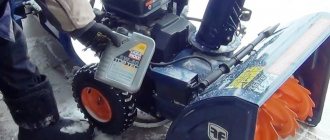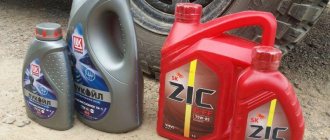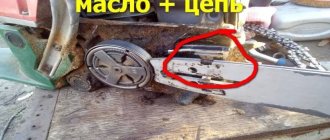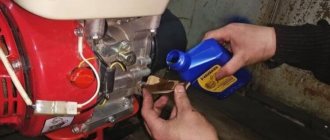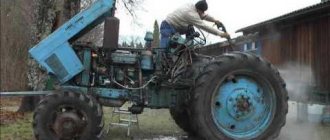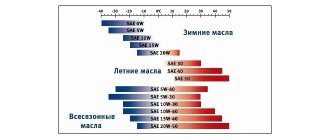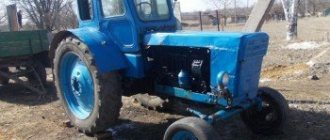The ZIL 130 (508) engine was installed on ZIL-130 and ZIL-131 trucks. The design of the ZIL 130 engine had many similarities with the engine of the executive model ZIL-111, but in general the engine models had a low degree of unification. The engine volume was reduced to 6 liters, a two-chamber carburetor was installed and it was equipped with a speed limiter. Seven-liter engines are called ZIL-375 and are used in trucks of the Ural Automobile Plant. The increase in volume was achieved by increasing the radius of the cylinders to 108 mm, while maintaining the piston stroke of 95 mm.
Description
This engine was installed on all ZIL 130 trucks, as well as on the ZIL 131. Therefore, when studying the design, you can see that the ZIL 131 engine resembles the motor installed in the ZIL 130.
The two devices were not significantly unified. The version installed in the ZIL 130 was slightly reduced in volume, it became six-liter, so as a result, less gasoline is consumed. In addition, the engine received a carburetor system with two chambers, and speed limiting is also provided.
The ZIL 375 engine has more power, the volume of which is 7 liters. As a rule, this unit is used by Avtomobilny JSC. As a result, the radius of the cylinders and the piston stroke changed significantly.
Device
This vehicle comes with a diesel engine and a liquid cooling system.
The power unit structure includes the following components and mechanisms:
The motor is attached to the support frame at three points. The front support mechanism is a bracket located under the timing gear cover. The rear support is presented in the form of claws of the coupling mechanism housing. Between the bracket and the front cross member of the support frame there are round cushions made of rubber.
All pillows are interchangeable, i.e. Pillows from the front support can be placed on the back and vice versa. The power unit is also connected to the front cross member of the frame using a reaction-type rod, on which rubber shock absorbers are installed.
Reaction type traction is used to keep the motor from longitudinal movement when the clutch is disengaged and the transfer case is engaged or while the vehicle is braking.
The engine suspension mechanism includes: front and rear mount, thrust buffer, connecting rod, bracket, mounts and mounting bolts.
The number is located on the tide of the block near the compressor, where the mounting eye is screwed in.
Cooling system
The design of the ZIL-131 engine cooling system consists of:
When the engine is warm, coolant flows from the radiator into the water pump element. Under pressure, it moves through two discharge pipes and enters the left and right block of cylindrical elements. Moving through the windows in the inter-cylinder partitions, the liquid cools the heads of the cylindrical parts.
Engine device
If you look closely at how the engine is designed, you will notice an eight-cylinder four-stroke unit, which has a carburetor system with a continuous supply of fuel. A characteristic distinguishing feature is the V-shaped placement of the cylinders. This allows you to get an impressively powerful and light weight motor.
- All pistons and cylinders move thanks to one crankshaft.
- In addition, the power unit is cooled with a special liquid, which is very convenient. The car owner can move in all weather conditions.
- Fuel is supplied continuously and forcibly, so the power unit operates without interruption.
Modifications
There are several options for the ZIL 130 engine. In the Soviet Union, they tried to create a truck that could be used for a long time.
The first vehicles were equipped with a simple carburetor format. The car engine capacity was 5200 cubic centimeters. But it soon became clear that it was impossible to develop the potential that was needed.
For this reason, a unit was manufactured with the same position of the cylinders, and there were already 8 of them. This was followed by an increase in power to one and a half hundred horsepower. Previous units did not have such capabilities.
Later, a completely new engine was manufactured, allowing it to reach a speed of almost 100 kilometers per hour. The key distinguishing feature is the four-stroke cycle and the valves located at the top.
How to maintain and how many liters of oil in a ZIL 130 engine
Anyone can change the engine oil for the ZIL 130, for this you need:
- Unscrew the drain plug.
- Unscrew the filter cap and pour out the contents.
- Unscrew the nut and remove the cover.
- Remove the seal.
- Take out the filter and remove the rod.
- The device must be changed in the reverse order.
- Pour oil into the engine, the car engine should then function for several minutes.
- Find out how much oil is inside using the dipstick. If necessary, top up. The volume of ZIL 130 oil should be 9 liters.
Tuning
If you are interested in more impressive power, you should install the Mopar 5.2, which has half a thousand horsepower. This is enough to move on high-quality road surfaces, as well as where there is none at all.
As for the exhaust system, pipes with a diameter of 63 millimeters are perfect here. As a result, exhaust gases will leave the car much more quickly. In addition, the sound will be lower.
The ZIL 131 engine, like the ZIL 130, can be converted into a very profitable diesel solution. Advantages of this option:
- this will make it possible to consume less fuel, up to 20 liters per hundred kilometers;
- Money will be saved since diesel fuel costs less than gasoline.
Removing the power unit must be careful; it is better to do this with a partner, as it is heavy and parts can be damaged.
Next, welding is carried out. This procedure is provided so that the new option fits in size. The new power unit, which has been converted into a diesel engine, is placed in the prepared place.
After this, the exhaust system is modified. In addition, the power system should be bled so that unnecessary air escapes.
In Soviet times, there was no talk about tuning, since such a concept did not exist. Some vehicle owners made changes on their own, installing a turbine from a tractor, changing the injection system. There were even cases when the fuel was cooled, which led to water hammer.
As tuning developed, in the first years of the 21st century, many experimental actions began with the ZIL-130 engine, which required a lot of money and effort to change. Still, there were car owners who tuned these devices on their own.
So, we should describe in more detail how the ZIL 130 engine was modified:
- The piston system was re-sharpened. The result was an increase in compression ratio. You could buy these parts for your vehicle directly from the manufacturer, or you could also do this from the Terra manufacturer.
- We replaced the cylinder head with one borrowed from the ZIL-130 BE.
- Replacing the ignition system with BSZ.
- The crankshaft was bored and the liners were also changed.
- Installation of a monoinjector.
- Other actions.
Some vehicle owners replaced all components, which made it possible to install distributed injection. In essence, this unit had much more power when compared with similar options. Replacement of the exhaust system is considered mandatory.
For this car, the system was covered with chrome with a pipe 200 millimeters shorter, the power increased by 50-100 horsepower. Another tuning variation was the installation of a branched exhaust system. As a result, with correct calculations it was possible to increase power by 70-120 horsepower.
Answers (2)
I recommend filling the ZIL 130 manual transmission with universal mineral gear oil TAD-17 (TM-5-18), and TSp-15K and TSp-10 are also suitable.
The oil volume in the box is 5.1 liters; you need to fill it to the level until oil flows from the filler hole.
Interval - every 30,000 km or depending on operating conditions.
LUKOIL TM-5 85W-90 is a modern gear oil of medium viscosity. Semi-synthetic with an effective package of the latest additives. Specially created for use in manual transmissions of any type. It is highly resistant to wear, corrosion and oxidation processes. Has an extended working life. With the constant use of LUKOIL TM-5 85W-90 transmission oil, the degree of energy losses is reduced due to a decrease in the degree of friction between parts, and the smoothness of gear shifting improves. The oil guarantees reliable operation of a mechanical transmission under any operating conditions over a wide range of operating temperatures. With uv. Igor
1. FILLING CAPACITIES OF ZIL-130 CARS
Engine lubrication system with oil cooler. 8.5
Engine cooling system without heater and preheater. 26
Engine cooling system with heater and preheater. 29
2. BASIC DATA FOR ADJUSTMENT AND CONTROL OF ZIL-130 CARS
Clearance between valve stem and rocker arm for intake and exhaust valves on a cold engine, mm. 0.25—0.3
Gap between breaker contacts, mm. 0.3—0.4
Gap between spark plug electrodes, mm, . . 0.85—1
Oil pressure in the lubrication system of a warmed-up new
engine, kPa (kgf/cm2). 196—392 (2—4)
Minimum permissible oil pressure in the lubrication system, kPa (kgf/cm2):
at idle speed. 49 (0.5)
at a vehicle speed of 40 km/h in fifth gear. 98 (1)
Air pressure in the brake system, kGb (kgf/cm2) 588–755 (6–7.7)
Normal fluid temperature in the engine cooling system, °C. 80—95
Deflection of fan drive belts, power steering pump and generator under the influence of
force 40 N (kgf), mm. 8-14
Deflection of the compressor drive belt under the influence of
force 40 N (4 kgf), mm. 5-8
Free play of the brake pedal when installing a combination valve, mm. 40—60
Distance from brake pedal to floor at full
AutoNews / Reviews / Tests
How much oil is in a box of ZIL 130
How much oil is in a ZIL 130 box?
Keywords: ZIL-130 gearbox, ZIL-130 chassis
gearbox is attached to the clutch housing with 4 studs screwed into the clutch housing. Centering of the box is carried out along the flange of the cover 4 of the rear bearing of the drive shaft.
In the right wall of the crankcase there is a screw plug 57 for the control and filling hole, through which the box is filled with oil in the absence of a power take-off box.
In the left wall of the crankcase, at the bottom, there is a drain hole, closed by a screw plug 60, which is equipped with a magnet that attracts small particles of metal from the oil. On both sides of the crankcase there are two hatches with flanges for attaching the power take-off. It is allowed to take from the box a power of less than 22 kW (30 hp).
Rice. 40. Gearbox ZIL-130:
1 - drive shaft; 2, 21, 30, 45 and 53 - bearings: 3, 28, 31 and 47 - retaining rings; 4 — cover of the rear bearing of the drive shaft; 5 — synchronizer for fourth and fifth gears; 6 — fourth gear bushing; 7 and 40 - gear pair of fourth gear; 8 and 58 - gear pair of third gear; 9 — fork for shifting fourth and fifth gears; 10 — fork for shifting second and third gears; 11 — ZIL-130 gearbox cover; 12 — installation sleeve; 13 — retainer ball; 14 — clamp spring; 15 — gear shift rod lock pin; 16 — lock ball; 17 — synchronizer for second and third gears; 18 and 34 - second gear gear; 19 — fork for shifting first gear and reverse gear; 20 — first gear and reverse wheel; 22 — parking brake bracket; 23 — speedometer drive worm; 24 — parking brake drum; 25 — flange with reflector; 26 - nut; 27 and 51 — oil seals; 29 — intermediate shaft nut; 32 — gearbox housing; 33 - driven shaft; 35, 39 and 41 - support washers; 36 and 42 — locking rings; 37 — reverse gear of the intermediate shaft; 43 — intermediate shaft; 44 — intermediate shaft gear; 46 - plug; 48 — rubber ring; 49 — locking finger; 50 - roller bearing; 52 — locking plate; 54 — spacer sleeve; 55 - axis of the reverse gear block ; 56 — block of reverse gears; 57— threaded plug for the control and filler hole of the ZIL-130 gearbox; 58 — power take-off hatch cover; 59 — speedometer drive gear; 60 — drain plug with magnet; 61 — breather; 62 — fuse for engaging first gear and reverse gear; 63 — axis of the intermediate lever; 64 — spherical support body; 65 — gear shift lever clamp; 66 — lever support; 67 - spring; 68 — gear shift lever; 69 — intermediate lever; 70 — intermediate lever block; 71 — rod for shifting first gear and reverse gear; 72 — shift rod for fourth and fifth gears; 73 — shift rod for second and third gears; 74 - fitting for the speedometer flexible shaft.
ZIL 131 Oil change + maintenance. Centrifuges
First oil
after purchasing
a ZIL
oil
leaks , carry out maintenance, replace the gasket and repair kit...
Gearbox ZIL ZIL 130 cross-section
training stand boxes
transmission
The speedometer drive consists of a five-way worm 23 and a gear 59, which has seventeen teeth (gear ratio of the worm pair of the speedometer drive is 3/4).
When changing the oil, as well as when disassembling the ZIL-130 gearbox, do not allow dirt or sand to get into it, as this can cause jamming of the gears rotating on the driven shaft. It is necessary to clean the magnet of the drain plug and wash the air channels of the breather screwed into the installation bolt of the cover. Clogging of the valves causes an increase in pressure in the crankcase, which leads to oil leakage.
When disassembling the ZIL-130 gearbox, you need to check the reliability of locking and the tightening of nuts 26 and 29; the tightening torque must be at least 250 N • m (25 kgf • m). Locking of these nuts is carried out by pressing the thinned edge of the nut into the groove of the shaft. Press the edge of the nut with a bit with a rounded end to prevent tearing. You need to unscrew the nuts with a long-arm wrench without first straightening the depressed edge of the nut.
Maintenance and how many liters of oil in ZIL 130
The oil in the ZIL 130 engine is changed every 6-10 thousand kilometers, depending on how the vehicle is used. The oil volume in the ZIL 130 engine is 9 liters.
The engine cooling system contains 28 liters of specialized fluid. The cooling system should be flushed every 40–50 thousand kilometers.
Let's look at how major repairs are carried out. Repairing the engine of this vehicle is not easy, since the procedure itself is slightly different from repairing other cargo vehicles that were manufactured in the Soviet Union. Currently, not all automobile mechanics know how to repair this engine, because this unit is outdated, it was replaced by modern new generation engines, the design of which is significantly different.
Naturally, before disassembling the engine, it should be removed from the car. This is not difficult to do; you just need to disconnect all the systems and pull everything out together. The disassembly procedure is the same as for the GAZ-53.
After completing the disassembly procedure, you should thoroughly rinse all parts to begin diagnostics. The parts are washed with kerosene; it must first be brought to a temperature of 60-70 degrees.
After the parts are washed, you should determine which elements can still be used and which require replacement. If measurements demonstrate that the parts need to be turned, they are sent to specialized machines.
After this, you should check how well the pumps are working. Based on experience, the shaft and support bearing are subject to wear, but this is not always the case. In addition, be sure to install new crankshaft bearings, because they often wear out significantly on the inside.
Next, it is necessary to diagnose the cylinder head. There are often situations when, during crimping, the cylinder head turns out to be cracked - here argon welding would be appropriate.
When it is clear which components need to be replaced, you can start ordering and selecting. It should be mentioned that not in all cases it is possible to bore the cylinders in the required way, so you need to order a piston after boring. In most cases, liner kits are purchased for ZIL engines that are currently in use.
This is followed by the selection of spare parts for the cylinder head. Everything is standard here - 16 valves, guide bushings, valve seats, valve stem seals. If required, camshafts are selected. However, this does not happen so often when the journals on the camshafts are significantly worn.
When all the parts have been collected, repair and restoration activities can begin. The first stage is boring the crankshaft and cylinder block.
The crankshaft is placed on a specialized grinding machine. The specialist grinds the crankshaft to specific dimensions, and then grinds the journals at low speeds, using emery.
Unlike a crankshaft, the block is placed in a boring and honing machine, where the cylinder surfaces are worked on. Then specialists place the liners in special places and make adjustments to the pistons. The pistons themselves should be turned and adjusted accordingly.
To do this, remove the edges of the edges at the bottom. The weight should not vary by more than 50 mg. If the difference is more significant, misalignment may appear and the elements will begin to wear out more.
After the very first actions with the block are carried out, it is tried on. Experts check how accurate the operations are. If necessary, grind the inside of the sleeve again.
Only after this can you begin to grind the surfaces of the block. After all actions are completed, the elements are washed again.
In addition, the surface of the cylinder head is also processed. The latter must be extremely even, since a leak may appear when the gaskets are assembled and installed, disassembly and repair work will be required.
Assembly
This procedure is carried out as described in the documents offered by the manufacturer. These documents were released twice - in the 70s and 80s. First, the crankshaft and main bearings are installed. Then the piston part is installed. The specialist installs the connecting rods, they are properly adjusted in advance, and the connecting rod bearings are also installed.
After installing the kit liners, you can begin assembling the cylinder head. First, replace the bushings, which were previously processed by a specialist. Then they install the valve seats, after which they install the camshafts, rods, springs, valves and valve stem seals.
After completing the assembly of the block and head, they can be combined into one structure. To solve this problem, gaskets are provided. The final stage is the installation of the crankcase pan and pumps. The final steps are to install the carburetor and ignition system, pour oil into the ZIL 130 engine. If everything turned out well, you can start running in the engine.
Run-in
An important procedure is running in the engine after completion of work. It is carried out in different modes and under different temperature conditions. In this case, it is better to use a mixed method, running in a truck.
The procedure is carried out at a specialized stand. Many home-grown automotive mechanics perform this directly on the vehicle, but this should not be done. If everything worked out, the engine is ready for use and can be installed on the car.
Cabin and onboard platform
The ZIL model 4331 cab is equipped with excellent heat and sound insulation, which allows you to talk inside the truck without raising your voice, and also not experience inconvenience due to cold weather. There are three seats, one of them is the driver's seat.
All seats are equipped with seat belts. itself is located on two pairs of shock absorbers.
The design is solid, it is a single block - if necessary, it can be folded forward very easily.
The sides of the metal platform are folding, with the front one having a greater height and the side ones slightly less. If necessary, you can install an awning on the frame.
ZIL-4331 ceased production in 2004, but the Likhachevsky Automobile Plant plans to restart production of these small trucks in 2014.
Despite some shortcomings, this model is still popular. The main advantage of this truck is its extremely low price. In good condition, you can buy a ZIL-4331 for only 200,000 rubles.
Excellent ones allow it to be used in the most extreme conditions.
This section contains information about Zubr 2a grain crushers and other models.
This is an extremely durable and easy to repair machine. Many samples produced back in the Soviet years still continue to travel on the roads of the CIS countries.
Inexpensive to maintain and easy to operate, the truck is all you need on commuter lines.
In the following video you will find out why ZIL-4331 is most often used as a watering machine:
Engine ZIL 130
Short description
The ZIL 130 (508) engine was installed on ZIL-130 and ZIL-131 trucks. The design of the ZIL 130 engine had much in common with the engine of the ZIL-111 model, but in general the engine models had a low degree of unification. The engine was reduced to 6 liters
, a two-chamber carburetor is installed and equipped with a speed limiter. Seven-liter engines are called ZIL-375 and are used on trucks of the Ural Automobile Plant. The increase in volume was achieved by increasing the radius of the cylinders to 108 mm; the piston stroke of 95 mm was retained.
Cylindrical block
The ZIL 130 cylinder block is cast iron, with a water carrier jacket and insertable wet sleeves. To increase the rigidity of the water jacket, it is divided into partitions into closed power circuits. The cylindrical liners are cast from SCh18-36 cast iron with a ferrite content limited to 5%. A 50 mm insert of corrosion-resistant austenitic cast iron is inserted into the upper part of the liner (this ensures a service life of the hoses of up to 200 thousand km). The sleeve thickness is 7.5 mm, the sleeve height is. 188.5 mm. The camshaft is installed in the cylinder block.
service
Changing engine oil in the ZIL-130 engine
produce in the range from 6000 to 10000 km depending on operating conditions. Engine oil volume
ZIL-130 is 9 liters.
What kind of oil should I pour? For engines, it was recommended to use motor oils throughout the season up to minus 30 ° C. oil M-6/10 V (DV-ASZp-SE) and M-8B at temperatures below .30 ° C ASZp-6 (M-4 / 6V,). According to the SAE classification,
SAE 10W-40
oils In areas with temperatures below .25 ° C it is possible to pour synthetic SAE 5W-40, 0W-30. In hot climates, 15W-40 mineral oil is also permitted. The engine cooling system
of the ZIL-130 car contains 28 liters of coolant.
After 40,000.50,000 km it is recommended to flush the cooling system. Spark plug
. A-11 or A-11B. The gap between the electrodes in summer is 0.8. 0.95 mm, in winter it is recommended to reduce the gap to 0.6-0.7 mm.
Onboard tractor vehicles (ZIL-431510 - long-wheelbase; dimensions in the diagram in brackets), have been produced by the Likhachev Moscow Automobile Plant since 1986. They are modernized vehicles of the ZIL-130 family, produced since 1962. Since 1977, the ZIL-130 car has been produced. 130-76, and since 1980 - ZIL-130-80. The body is a wooden platform with metal transverse base bars, with folding rear and side sides. Installation of extension sides and an awning with a frame is provided. On ZIL-431510 the side panel consists of two parts. The cabin is three-seater, located behind the engine. The driver's seat is adjustable in length, height and backrest angle.
Car modifications:
ZIL-431411 and ZIL-431511
— “HL” version for cold climates (up to minus 60°C);
ZIL-431416 and ZIL-431516
- for export to countries with temperate climates;
ZIL-431417 and ZIL-431517
- for export to countries with tropical climates;
ZIL-431917 and ZIL-432317
- with shielded electrical equipment for export to countries with temperate and tropical climates;
ZIL-431610 and ZIL-431710
- gas-cylinder vehicles running on compressed natural gas and gasoline;
ZIL-431810
- gas-cylinder vehicles running on liquefied gas (based on 431410).
In addition, the following car chassis are produced:
ZIL-431412
— chassis ZIL-43 1410;
ZIL-495710
- agricultural dump truck chassis;
ZIL-431512
- chassis ZIL-431510;
ZIL-495810
- chassis of a construction dump truck.
Engine.
Maud. ZIL-508.10, petrol, V-shape. (900), 8-cyl., 100×95 mm, 6.0 l, compression ratio 7.1, operating order 1-5-4-2-6-3-7-8, power 110 kW (150 hp) s.) at 3200 rpm, torque 402 Nm (41 kgf-m), fuel pump B10 - diaphragm, K-90 carburetor with forced idle economizer or K-96, K-88AT, K-88AM, air filter - inertial oil filter VM-16 or VM-21.
Transmission.
The clutch is single-plate, with peripheral pressure springs, the release drive is mechanical. Transmission - 5-speed. with synchronizers in II, III, IV and V gears, gear. numbers: I-7.44; II-4.10; III-2.29; IV-1.47; V-1.00; ZX-7.09. Cardan transmission consists of two consecutive shafts with an intermediate support. The main gear is a single hypoid, gear. number 6.33. A drive axle with a double bevel-cylindrical main gear can be installed. number 6.32.
Wheels and tires.
Wheels - disc, rim 7.0-20, fastening with 8 studs. Tires 9.00R20 (260R508) mod. I-N142B-1 or 0-40BM-1, Installation of tires mod. I-252B or VI-244. Air pressure, kgf/cm. sq.: ZIL-431410 - tires I-N142B-1 and O-40BM-1 - front - 4.0, rear - 6.3; tires I-252B and VI-244 - front - 3.0, rear - 5.8; ZIL-431510 - tires I-N142B-1 and O-40BM-1 - front - 4.5, rear - 5.3; tires I-252B and VI-244 - front - 3.5, rear - 5.8. The number of ears is 6+1.
Suspension.
The front is on two semi-elliptic springs with rear sliding ends and shock absorbers; the rear one is on two main and two additional semi-elliptic springs, the ends of the additional springs and the rear ends of the main ones are sliding.
Brakes.
The service brake system is with drum mechanisms (diameter 420 mm, width of the front linings 70, rear linings 140 mm, cam release) with a dual-circuit pneumatic drive, with a brake force regulator. Brake chambers: front - type 16, rear - type 24/24 with spring energy accumulators. The parking brake is applied to the brakes of the rear wheels from spring energy accumulators, the drive is pneumatic. The spare brake system is combined with the parking one. The trailer brake drive is combined (two- and single-wire). Upon request, vehicles can be equipped with a brake drive without separation along the axles and with a single-line drive for trailer brakes (ZIL-130-80 vehicle brakes). There is an alcohol fuse against condensate freezing.
Steering.
The steering mechanism is a screw with a ball nut on circulating balls and a piston-rack that engages with the toothed sector of the bipod shaft, the hydraulic booster is built-in, gear number 20, oil pressure in the booster is 65-75 kgf/cm. sq.
Electrical equipment.
Voltage 12 V, ac. battery 6ST-90EM, generator 32.3701 with voltage regulator 201.3702, starter ST230-K1, ignition distributor 46.3706 with centrifugal and vacuum regulators, ignition coil B114-B, transistor switch TK102-A, spark plugs A11. Some vehicles may be equipped with a contactless ignition system. Fuel tank - 170 l, gasoline A-76; cooling system - 26l, water or antifreeze - A40, A65; engine lubrication system - 8.5 l, all-season up to minus 30°C oil M-6/10V (DV-ASZp-10V) and M-8V, at temperatures below minus 30°C - oil ASZp-6 (M-4/ 6B); power steering - 2.75 l, all-season oil grade P; gearbox - 5.1 l, all-season oil TSp-15K, substitute - oil TAP-15V, at temperatures below minus 30°C oil TSp-10; hypoid final drive housing - 10.5 l, all-season hypoid gear oil TSp-14 gip, at temperatures below minus 30°C oil TSz-9 gip; two-stage final drive housing - 4.5 l, gearbox oil; shock absorbers - 2×0.41 l, liquid AZh-12T; windshield washer reservoir - 2.7 l, NIISS-4 liquid mixed with water; fuse against condensate freezing - 0.2 l, ethyl alcohol.
Oil for Zila
We will talk about motor oils used in car engines of the Likhachev Plant.
The AMO ZIL association currently produces a wide range of vehicles for various purposes using both its own engines and engines from other manufacturers. This includes a whole range of trucks and buses based on the Bychka with diesel engines from the Minsk Motor Plant MMZ D-245.12 and MMZ D-245.9, trucks for various purposes (including those with a 6x6 wheel arrangement for the Ministry of Defense) with diesel engines ZIL-645 and ZIL- 0550 and their modifications, as well as with forced ignition (gasoline) engines of the ZIL-508.10 and ZIL-509.10 series. At the customer's request, cars can be equipped with engines from the Yaroslavl Motor Plant.
It would not be superfluous to mention that according to the results of an inspection carried out by the 25th State Research Institute of the Ministry of Defense of the Russian Federation and CJSC NAMI-CHEM, it was established that up to 50% of brake fluids and 90% of coolants in terms of their quality pose a threat to traffic safety and worsen the environmental situation in the city. A similar situation is developing in the motor oil market. Therefore, let me give advice to consumers of automotive equipment: before filling this or that type of fuel and lubricants, have it checked in specialized stationary or mobile laboratories.
People often ask which oils are better to use for ZIL cars: synthetic (semi-synthetic) or mineral? ZILs can be called “workhorses”, the purpose of which is in everyday work, and not in setting records for speed, service life and carrying capacity. It is apparently inadvisable to feed such a “horse” with biscuits - it needs high-quality “oats”.
You just need to remember that turbocharged engines require oil group DM (or higher), and with atmospheric process - group G2 (or higher).
In gasoline engines used to equip ZIL vehicles, it is recommended to use oil M-8V GOST 10541-78 (or its analogues produced according to specifications), as well as Lukoil oils M-8V (and) produced by JSC "Lukoil Volgogradneftekhimpererabotka" or M- 8V with additive OLOA-4352 produced by . It is also possible to use long-lasting all-season oil M-6z/10V GOST 10541-78 (with a higher quality set of additives). It is also possible to use oils of group G1 (or higher).
How to change the oil in a ZIL 131 engine?
The procedure for changing the engine oil of your car follows a certain order:
- Before draining the old oil, you need to warm the car engine to operating temperature. If the engine has already warmed up to the required temperature, then you should wait eight minutes, this is done in order to slightly lower the oil temperature for your own safety when you drain it.
- After this, we take a suitable container and we will drain the waste into it. An old oil can will do if you cut out the side wall with a knife.
- To drain the oil, unscrew the cap under the crankcase. Usually, the lowest place on the pallet. To begin with, unscrew the crankcase plug with a wrench, and finally with your hands, but first put a container for working out, because the oil will flow out immediately.
- The oil will drain from the engine quickly, usually no more than four minutes. But it is not possible to completely remove old oil from the engine. There is no need to be afraid of this, since often less than one to three percent of the old oil remains in the engine.
- The waste is merged and the color is assessed for the presence of unknown components. Based on such factors, you will find out whether the engine needs to be cleaned or an oil change without flushing is needed. Then, pour in the recently purchased oil, change the oil filter, and the oil change can be considered complete.
- While you are pouring new oil into the engine, constantly check the level using the oil dipstick. It is necessary to fill according to the level, between the minimum and maximum marks. Fill in 90 percent of the norm and then top up, adjusting with the dipstick.
Characteristics of the ZIL 130 engine
| Parameter | Meaning |
| Configuration | V |
| Number of cylinders | 8 |
| Volume, l | 6,0 |
| Cylinder diameter, mm | 100 |
| Piston stroke, mm | 95 |
| Compression ratio | 6,5 |
| Number of valves per cylinder | 2 (1-inlet; 1-outlet) |
| Gas distribution mechanism | OHV |
| Cylinder operating order | 1-5-4-2-6-3-7-8 |
| Rated engine power / at engine speed | 110.4 kW - (150 hp) / 3200 rpm |
| Maximum torque/at engine speed | 401.8 N m / 1800-2000 rpm |
| Supply system | Carburetor fuel supply, K-88A carburetor, two-chamber, with accelerator pump and economizer |
| Recommended minimum octane number of gasoline | 76 |
| Environmental standards | Euro 0 |
| Weight, kg | 440 |
Crankshaft
Crankshaft ZIL 130 steel (steel 45), forged, four-joint, five-bearing. The connecting rod and main journals are hardened. The crankshaft is made in a cross-shaped pattern for better engine balancing.
| Parameter | Meaning |
| Diameter of main journals, mm | 74,48 – 74,50 |
| Diameter of connecting rod journals, mm | 65,48 – 65,50 |
The weight of the ZIL 130 wheel is 53.75 kg, with the flywheel - 77.917 kg, with the clutch and pulley - 102.62 kg.
Cylinder block
The ZIL 130 cylinder block is cast from cast iron, with a load-bearing water jacket and insertable wet liners. To increase rigidity, the water jacket is divided by partitions into closed power circuits. The cylinder liners are cast from SCh18-36 cast iron with a ferrite content limited to 5%. An insert made of corrosion-resistant austenitic cast iron is pressed 50 mm into the upper part of the liner (this ensures a liner life of up to 200 thousand km). The thickness of the sleeve is 7.5 mm, the height of the sleeve is 188.5 mm. The camshaft is installed in the cylinder block.
Piston
The pistons are cast from an aluminum alloy and coated with tin to speed up the running-in of the piston skirt to the cylinder. The piston pin axis is offset by 1.6 mm from the piston axis.
| Parameter | Meaning |
| Diameter, mm | 100,0 – 100,06 |
| Compression height, mm | 62,5 |
| Weight, g | 782 – 822 |
The piston pins are steel, floating, hollow. The outer diameter of the finger is 28 mm, the inner diameter is 19 mm. Piston pin length – 82 mm.
Specifications
Overall dimensions of ZIL-130:
- length – 6675 mm;
- height – 2400 mm;
- width – 2500 mm;
- wheelbase – 3800 mm.
The rear track of the car is 1790 mm, the front track is 1800 mm. The truck has a ground clearance of 275 mm.
The weight of the machine is 4300 kg, the load capacity is 5000 (6000) kg.
Fuel consumption ZIL-130
The fuel consumption rate of the ZIL-130 model is 32 l/100 km (in winter it increases to 40 l/100 km). Taking into account the large fuel tank (175 l), the car can travel about 500 km without refueling.
Dimensional and weight characteristics of ZIL-4331
The car is relatively compact, its dimensions today allow it to be used in city conditions - most road structures will not become an obstacle in the way of this truck:
- total length from front to rear bumper
– 6,370 mm; - body width
from the axis of the left rear-view mirror to the right - 2,500 mm; - height from the tread to the side lights
on the roof – 2,655 mm.
The wheelbase is also quite short for a car of this size:
- the distance between the front wheels is 1,930 mm;
- between the rear ones – 1,850 mm.
The ground clearance can please even the most demanding drivers and those who carry out transportation on extremely poor roads: its value is as much as 330 mm. The average track width is 1,930 mm.
The weight of the car itself is 4,820 kg (excluding refueling fluids). The maximum load that the ZIL-4331 can carry is 6,000 kg.
Thus, this truck cannot seriously compete with foreign analogues due to its rather high fuel consumption and low load capacity. But the ease of repair and low cost make the car in question extremely popular.
The total weight of the ZIL with a full load and filling fluids is approximately 11,700 kg.
This weight can easily withstand most of the various bridges and other similar engineering communications on the roads.

